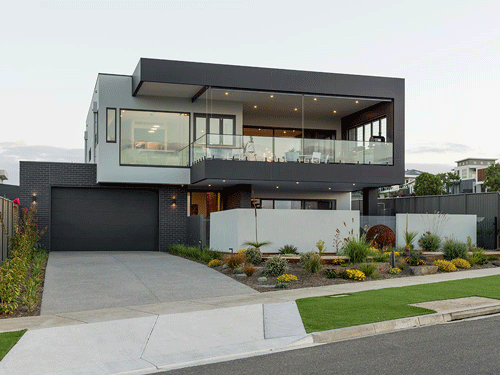Engineering marvels of sloping block construction
Have you ever pondered if a plot of land with a sharp slope would be acceptable for your ideal house to be built on? Building on sloped land has become an intricate combination of design, engineering, and creativity in Melbourne. The world of slope block building is examined in this essay, revealing the difficulties, creative fixes, and architectural marvels that characterize this unusual industry.
Construction of Sloping Blocks: A Review
Building using sloping blocks means constructing on terrain with considerable elevation fluctuations. Such vistas are stunning, but they also present difficult obstacles. These difficulties affect the completed structure’s stability and architectural design when construction is complete.
Sloping block construction
issues include erosion and drainage problems!
Managing erosion and drainage on sloping blocks is one of the biggest concerns. On steep slopes, rainwater may rapidly erode the soil, endangering the integrity of the foundation. To tackle this, engineers include efficient drainage systems and erosion prevention strategies into their designs.
Building Stability
Ingenious engineering is needed to maintain a strong foundation on a slope. Common options include piling and deep foundations, which provide support to stable soil layers. Additionally providing stability, cantilevered designs enable certain parts of the structure to protrude beyond the slope.
Design Adjustment
The challenge of modifying traditional designs for atypical environments is one that architects often encounter. The difficulty serves as inspiration for them as they design arrangements that flow naturally with the topography. In addition to improving aesthetics, retaining walls and terracing provide useful areas.
Fresh Engineering Approaches
Terracing as well as retaining walls
The unsung heroes of sloping block building are retaining walls. They retain soil, reducing erosion and establishing level areas. A scary incline may be turned into a blank canvas for imaginative landscaping by using the terracing method, which divides the slope into a number of level platforms.
Strong Foundations and Piling
Piling is the process of deeply burying vertical columns into the earth until they reach stable layers. This method uniformly distributes the weight of the structure, assuring durability. When there are steep slopes, when shallow footings wouldn’t be enough, deep foundations are very important.
Cantilevered Structures
By horizontally extending portions of the structure over the slope’s edge, cantilevers defy gravity. By using this creative design strategy, stability is maintained while space is maximized. It is a spectacular illustration of architecture and engineering working in unison.
Amazing Sloping Block Multi-Story Designs in Architecture
Multi-story designs may play around with sloping blocks. Taking use of the elevation variations, architects design residences with separate levels that provide solitude and breathtaking views. These residences often have open floor plans that connect indoor and outdoor areas.
Resilience and Green Roofs
Sustainable construction methods haven’t been discouraged by the difficulty of doing so. Green roofs, which are covered with plants, absorb rainfall and provide insulation. They lessen the structure’s aesthetic effect while also enhancing energy efficiency.
Integrated Indoor-Outdoor Design
Living inside and outdoors may be combined thanks to sloping block structures. The interior is extended by balconies, decks, and terraces, providing a smooth transition between the outside and the building.
The Function of Technology
Visualization and 3D Modeling
Using 3D modeling, architects and engineers may see buildings before construction even starts in the digital era. By improving accuracy, this technology enables decision-makers to make well-informed choices on layout and design.
Software for Geotechnical Analysis
Software for geotechnical analysis is essential for assessing soil stability and recommending suitable foundation techniques. It helps engineers make data-driven choices that guarantee the security of the facility.
Cost-restraining variables in construction
Site Evaluation and Planning
The foundation of cost calculation is a thorough site study. Sloping blocks need a careful evaluation of the soil’s quality, the way it drains, and any geological dangers. Grading, excavation, and stabilization are a few preparation techniques that may be used.
Material Choice
Both price and aesthetics are impacted by the choice of building materials. Lightweight materials may be recommended on sloping blocks to lessen the stress on the foundation. These selections must, however, be in accordance with regional laws and the planned architectural design.
Services and Equipment
Due to the particular difficulties the terrain presents, sloping block building often requires specialized tools and experienced workers. Construction prices might vary depending on the project’s complexity and the availability of these resources.
Regulations and Permits
Local zoning ordinances
Navigating local zoning regulations that may specify height limitations, setbacks, and environmental concerns is necessary when building on a sloped block. To prevent legal issues, it is essential to follow these rules.
Environment Impact Evaluations
Environmental impact studies can be required due to the possibility of erosion and habitat destruction. These evaluations guarantee that the building will have the least possible impact on the ecology.
Scenic views are a benefit of sloping block construction.
Traditional flat properties cannot compare to the vistas that sloping plots provide. These panoramas may be made the focal point of a well-planned house, enhancing the quality of life.
Unusual Decorative Appeal
Sloping block residences stand out in the architectural environment because to their unique design. They exude exclusivity due to their interaction with nature, dynamic designs, and flexibility.
A rise in property values
Homes on sloping lots sometimes fetch greater prices since they are in high demand and hard to come by. Innovative building techniques and breath-taking scenery may pay you handsomely.
Selecting the Best Experts
Designers and Architects
Collaboration between architects and designers is crucial for developing a coherent concept that honors the client’s preferences as well as the terrain. They find inventive ways to reconcile form and function.
Contractors and Engineers
The architectural vision is brought to life by skilled engineers and contractors, who make sure that novel design concepts are carried out effectively and securely on difficult terrain.
Iconic sloping block structures: case studies
Fallingwater by Frank Lloyd Wright
Frank Lloyd Wright’s masterpiece Fallingwater is the perfect example of how architecture and nature can coexist in harmony. The clever engineering and creative ideas that went into this cantilevered house above a waterfall are evident.
Inn at Pierre
The Australian building The Pierre House serves as an example of how multi-story layouts on sloping blocks may seamlessly combine interior and outdoor areas. It combines the beauty of the outdoors with contemporary elegance.
Future Developments in Sloping Block Building
Sustainable Construction Methods
Sloping block buildings are anticipated to include even more environmentally friendly elements as sustainability gains prominence, such the integration of renewable energy sources and rainwater collection.
Utilizing smart technology
The improvement of living on sloping blocks will heavily rely on smart technologies. These technological advancements will increase comfort and convenience, from automatic shading systems to energy-efficient appliances.
Conclusion
Sloping block building serves as a tribute to human creativity in Melbourne’s constantly changing architectural environment. This building technique perfectly captures the interplay between nature and innovation, fighting erosion while also producing breathtaking works of art. The future of sloping block building offers even greater achievements as technology develops and sustainability becomes increasingly important.
view our projects
What is sloping block construction?
Sloping block construction refers to building on land with significant elevation changes, presenting both design and engineering challenges.
How do engineers manage foundation stability on sloping blocks?
Engineers use techniques like piling, deep foundations, and cantilevered designs to ensure stable foundations on uneven terrain.
What are some benefits of choosing sloping block construction?
Sloping block construction offers scenic views, distinctive aesthetics, and the potential for increased property value due to its uniqueness and desirability.







